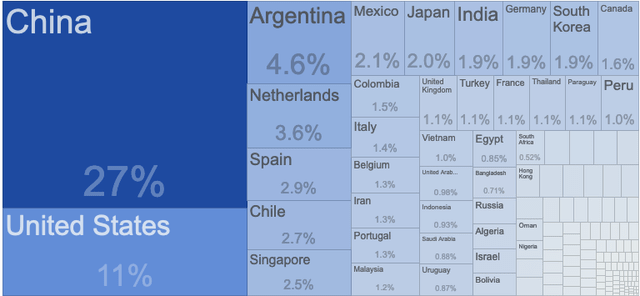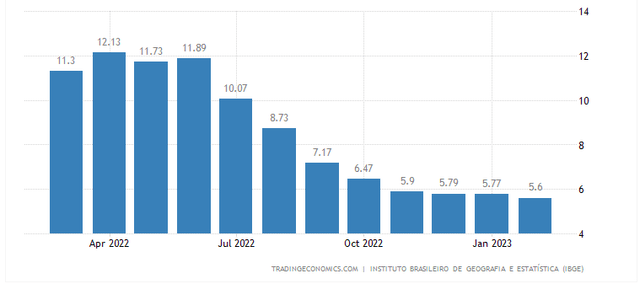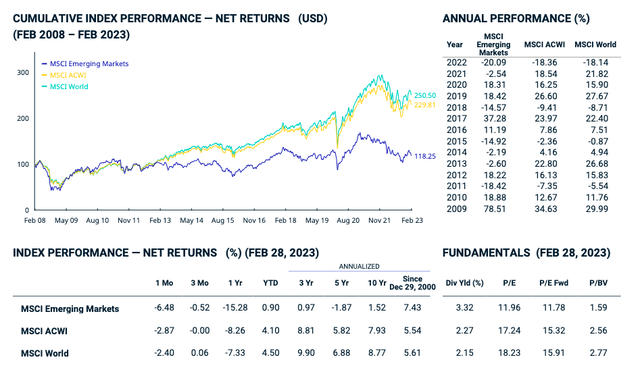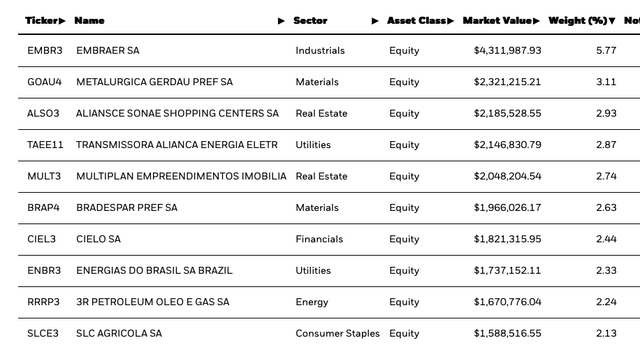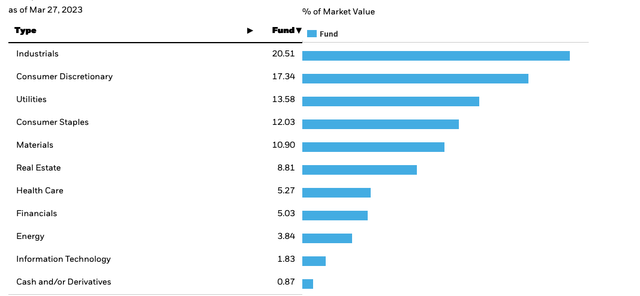EWZS: Reasonable Exposure To Small-Cap Consumer Stocks And Other Themes

Summary
- This is an intriguing small-cap ETF that is slightly overweight consumer stocks.
- Brazil's discount to emerging markets is attractive.
- Brazil should be able to outperform other emerging markets, in my view.
Brastock Images/iStock Editorial via Getty Images
Opportunity Overview
The iShares Brazil Small-Cap ETF (NASDAQ:EWZS) provides exposure to some small-cap equities in Brazil that may be otherwise hard to access on US exchanges. Valuation for this ETF is similar to the broader market, as it invests in small caps but has a slightly higher weighting in consumer stocks. Brazil's discount to emerging markets is intriguing even after factoring in industry weightings, and I believe this market could outperform other regional equities in the long run. I plan to accumulate this ETF and gradually add to consumer names, such as BRF SA (BRFS), on any potential dips this year. Even though risks are growing in emerging markets, a handful of markets, such as Brazil, are hard to pass on due to the favorable valuation and acceptable level of macro/political risks.
Brazil Economic Outlook
Brazil's economic growth is projected to reach 1.2% this year, slightly below the Latam average of 1.8%. One relative positive fact about Brazil is that it relies less on exporting to the United States (PMI is 49) and Europe (PMI is 47), and offers more exposure to commodities and China.
One factor that could cause Brazil to outperform is China's economic reopening this year, as around 27% of Brazil's exports go to China. Brazil's total exports to China are higher than its exports to the next 5 countries combined.
Brazil's Inflation
Inflation has improved for eight months in a row, and the February 2023 YoY inflation rate in Brazil is currently lower than that of the United States and Europe. The hawkish approach of Central Banks in Brazil has allowed the country's inflation rate to be below that of Europe and other regional markets such as Chile, Peru, and Colombia. However, consumer spending will still likely be under pressure due to slower growth, the higher cost of capital, and the lingering impacts of inflation.
Emerging Market Benchmarks
Emerging markets are not trading at very attractive levels, as the MSCI EM Index still trades at around 12x PE even after declining 20% in 2022. While emerging markets trade at an approximate 30% discount to the MSCI ACWI, there are cheaper markets found in some of the smaller emerging markets, many of which are in South America. Equities in regions like Southeast Asia and MENA are more expensive.
Emerging market equities have underperformed global markets in the past decade. Moreover, Brazil has also been a massive underperformer relative to other emerging markets, as the market has declined by over 50% in the past decade.
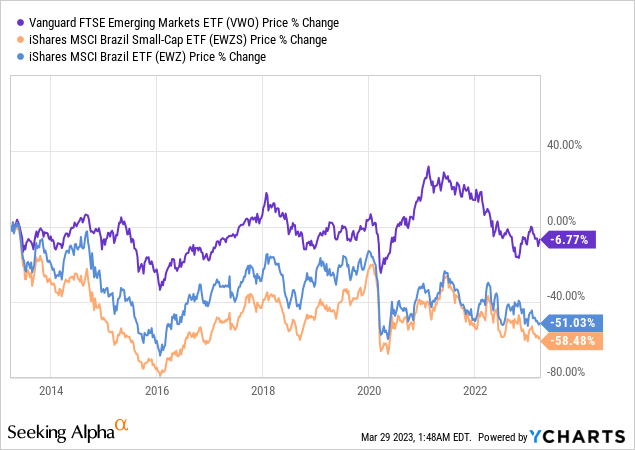
Consequently, equities in Brazil currently trade at around a 5x PE, which is more than a 50% discount to emerging markets on a price/earnings basis. One factor to note, before getting too excited about Brazil's discount, is that the MSCI Brazil Index invests heavily in themes like materials, financials, and energy, and has a lower weighting in consumer stocks. However, investing in an ETF like this can be a good approach if you want to access equity markets at a discount, rather than chasing consumer names with a higher valuation.
MSCI Brazil Index
MSCI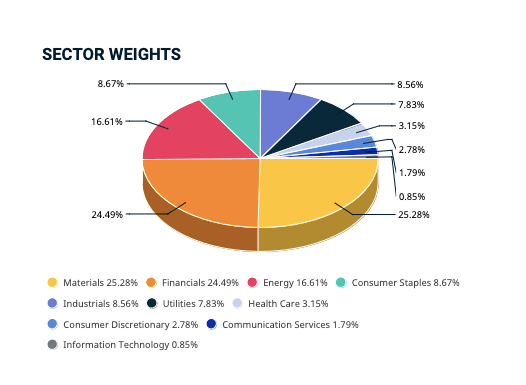
If you invest in Brazil, you will have much heavier exposure to themes like materials and energy and less exposure to consumer stocks. 20% of the MSCI Emerging Markets Index is comprised of consumer staples and consumer discretionary stocks, and another 20% of this index includes various IT companies such as Samsung (OTCPK:SSNLF), Taiwan Semiconductor (TSM), and Infosys (INFY).
MSCI Brazil | MSCI Emerging Markets | |
Materials | 25.3% | 8.78% |
Financials | 24.5% | 21.7% |
Energy | 16.6% | 4.7% |
Consumer Staples | 8.7% | 6.4% |
Industrials | 8.6% | 6.0% |
Source: MSCI
Moreover, most of Brazil's top exports include commodities, so investing in Brazil entails making a strong bet on commodities.
OEC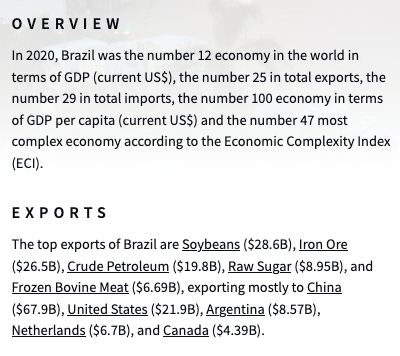
Accessing the Market via the iShares MSCI Brazil Small-Cap ETF
I have covered a lot of consumer stocks and banks in Brazil and have so far avoided ETFs. However, this looks like a good ETF to add to your portfolio to maintain exposure to Brazil while selectively shopping for stocks this year, especially during market sell offs. One benefit of this ETF is that it invests in 80 listed companies in Brazil, and many of these are locally listed companies. This fact is a major benefit for US investors, as US-listed ADRs are abundant, but there are only a handful of consumer ADRs in Brazil.
This ETF trades at around 5.4X PE and at 0.9x PB, which is roughly in line with the MSCI Emerging Markets index. However, it is crucial to note that this ETF invests more in consumer names, which should command a premium to the index. The main reason that its valuation is on par with the MSCI Brazil index is that it invests in small caps.
Since nearly 30% of this ETF's assets invest in consumer companies, investing in this ETF is a solid option if you want to invest in consumer stocks but avoid investing in some of the few consumer ADRs.
Regional Markets have Underperformed
Other markets like Chile and Colombia are trading in line with Brazil ( 5-6x PE and 0.9-1.3x book value). However, these markets are also both heavy financials/materials.
MSCI Chile Sectors
MSCI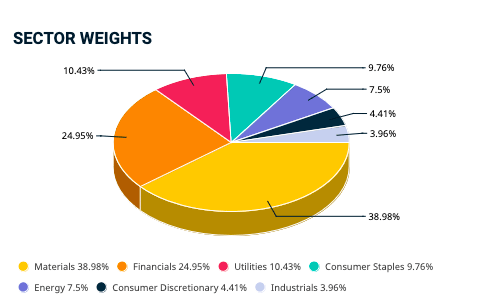
MSCI Colombia Sectors
MSCI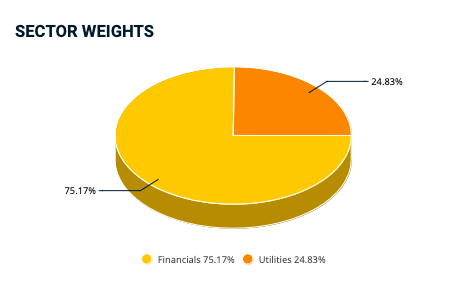
A lot of stocks in South America appear to be in a bottoming-out phase, as they have strongly underperformed other regional emerging stock markets. However, many regions that have significantly outperformed, such as Southeast Asia and MENA, trade at a higher valuation. The iShares MSCI Thailand ETF (THD) and iShares MSCI Indonesia ETF (EIDO) have outperformed significantly, but these markets trade at 22.1x and 13.8x earnings, respectively.
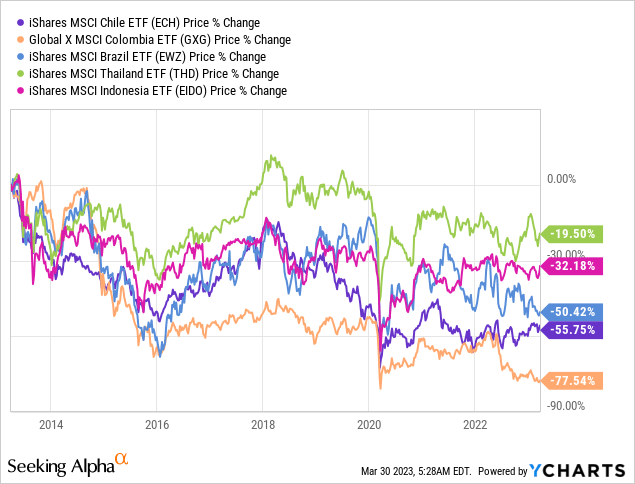
MENA is also another interesting benchmark because many of these countries, like Brazil and others, benefit from higher commodity prices. However, the equity markets in Latin America have not fully benefited from this trend, but this could change in the near future.

EM/Brazil Outlook
As geopolitical and economic risks accelerate in emerging markets, betting on discounted markets that have essentially been priced for the worst could be the safest bet. Countries like Brazil have already been punished enough by the market, mainly because of the new political risks. Consumers could have an edge by investing in smaller companies and investing in consumer companies. This is one of several reasons I prefer the iShares MSCI Brazil Capped ETF over other investment vehicles.
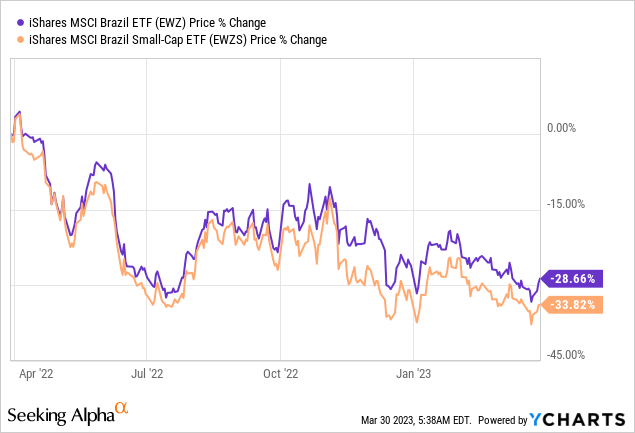
For the most part, the iShares MSCI Brazil ETF (EWZ) moves in line with this small-cap ETF, although it has slightly outperformed in the past year.
Risks to Consider
Some of the largest risks of investing in this ETF are emerging market specific risks:
- Sovereign defaults could increase in select emerging markets in 2023-2024, as the Federal Reserve continues to hike rates, so markets with a high % of external debt are at risk.
- Inflation is a huge risk in emerging markets, but has not impacted Brazil as severely. Brazil has kept interest rates above 13%, and has managed to bring YoY inflation below 6% for four months in a row.
- Economies that export to the United States/Europe are at risk, and have a higher trade/GDP ratio are at a high risk.
ETF specific risks: If you want to avoid themes like energy/materials, then it may be a better idea to avoid this ETF and invest in banking and consumer ADRs or other ETFs.
This article was written by
Disclosure: I/we have a beneficial long position in the shares of EWZS either through stock ownership, options, or other derivatives. I wrote this article myself, and it expresses my own opinions. I am not receiving compensation for it (other than from Seeking Alpha). I have no business relationship with any company whose stock is mentioned in this article.
